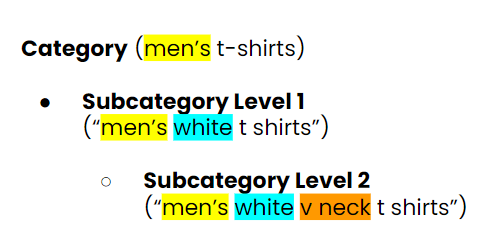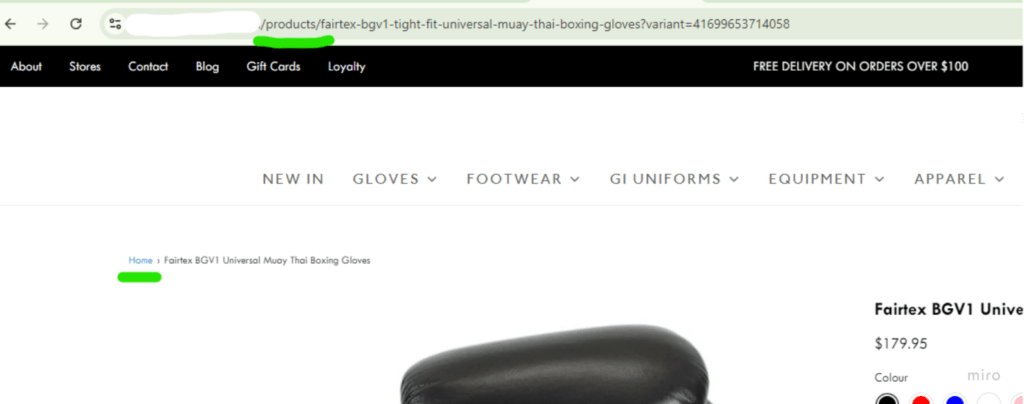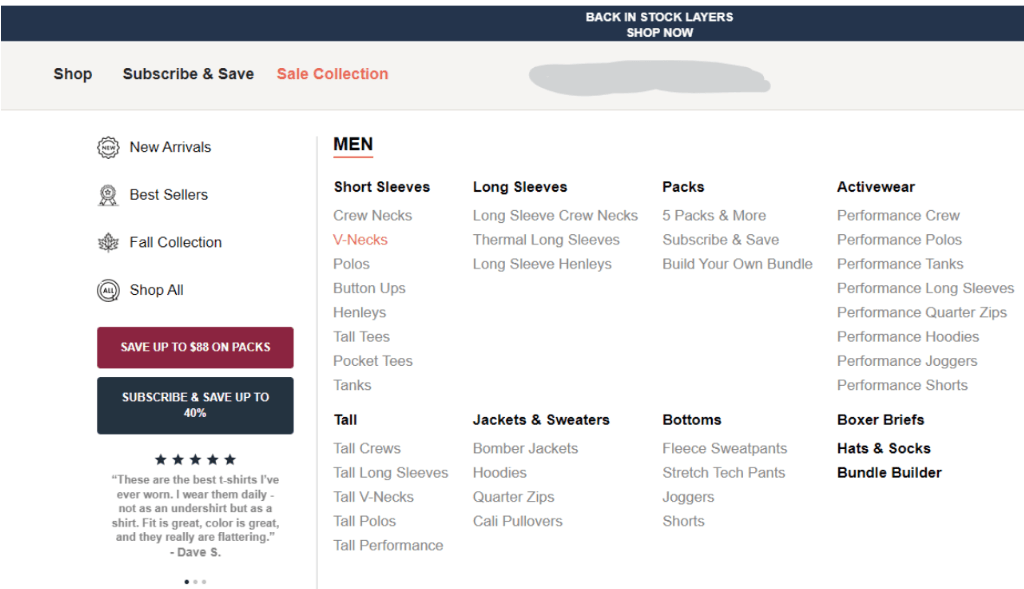Most buyers look for products on search engines like Google and Bing. Therefore, a well-optimized online store makes the huge difference between thriving and merely surviving for eCommerce business owners. Today, we’ll go over the critical steps, strategies, and best practices you need to ensure your online store draws in search engine traffic but also converts it into loyal clients.
But before we dive in, let’s talk about why eCommerce SEO is such a big deal for your store’s success. 🔥

SEO for eCommerce isn’t a one-and-done task—it’s a long-term journey. This is how it runs:
- Impressions: Your first priority should be ensuring that your website appears in search results for queries (keywords) related to your goods.
- Positions: You’ve probably heard that nearly 75% of clicks come from the first page of search results. That’s why getting into the top 10 positions on Google is crucial for driving organic traffic.
- Traffic: But it doesn’t stop there. SEO is a long game that continuously adapts, helping you turn searchers into consumers.
- Sales: A high ranking doesn’t just mean more traffic for your eCommerce store; it also builds credibility. Simple formula: customers trust your site—conversions and sales organically increase.
This detailed article was written by eCommerce SEO pros 🧘♂️:
- Oleksandr Kryvotsiuk has over 10 years of experience in eCommerce search engine optimization and marketing strategies.
- Veronika Kovalska has 5+ years as an eCommerce marketer with a focus on branding and digital strategies to drive targeted traffic to online stores.
👀 We’re here to help you discover the SEO tactics and, as a result, boost your store’s sales. By the end of this article, you’ll have a clear roadmap for growing your eCommerce store through effective SEO strategies.
We’ll start with the fundamentals before developing a successful, step-by-step SEO strategy.
- What is the most important SEO factor in eCommerce? | eCommerce SEO Foundation
- How Can You Compete with Amazon and eBay in a Google Search?
- What Are the Multilevel Structures?
- eCommerce SEO to Increase Impressions | Effective SEO Strategy
- WooCommerce, Magento, and what’s wrong with Shopify SEO?
- Shopify & Multi-level Structure
- Creating a Multi-Level Structure Through Customizing Shopify
- On-Page SEO to Improve Search Rankings
- Off-Page SEO to Build Domain Authority
- eCommerce SEO to Improve Rankings | Insights from Real Case Studies
- Key Takeaways
Main Points in One Short Video
Watch our latest video on this topic:
Dominate Search Engines
Don't let your products go unnoticed. Implement the latest SEO trends and watch your visibility soar.

What is the most important SEO factor in eCommerce? | eCommerce SEO Foundation
Google goes to great lengths to keep the principles of its search engine operation secret. There are over 200 factors in SEO. It’s, of course, unofficial. But let’s step by step go through this. These factors include technical aspects, content, authority, and behavior. In eCommerce, the most important factor is. What do you think?
Let’s compare: “Men’s white t-shirt” and “Men’s white v-neck t-shirt.”
You can see in the picture that depending on the context, you will have a different result, right?

So input is very, very important. If you look at the picture, you can understand that the appropriate output was related to the input.
So what do you think is the most important factor in eСommerce?
Relevance
Everyone must know that relevance is the most important for SEO. Users are accustomed to refining their queries to save time when searching. Of course, the search engine algorithms are tuned to understand user intent, ensuring that the most relevant pages are displayed to save users time and effort.
Search engine users refine their queries in different ways. For instance, some might search for a “t-shirt,” while others may look for a “white t-shirt” or “red t-shirt with a v-neck,” even color material, eco, and so on. Because we have lots of different intentions, Google strives to generate search results that are most relevant to these queries.
So 80% of all search queries are queries with a second and higher level of detail.

For users, such queries are important and very helpful because they convey to the search engine what specifically a user needs (“red v-neck t-shirt for men”), thereby saving the user’s browsing time.
The search engine (ex. Google, Bing) “understands” this (“red v neck t-shirt for men”) and shows the results that most closely match the user’s query. This way, the user quickly gets the most relevant information.

Surely your store must have the same vision, and you must be at the top. Google, Bing, and other engines want to help you rise up, but you need to follow the rules—the same rules as are in the picture above.
You must have the relevant title, relevant description, separate page and URL, and relevant content. And if you have all of this, it seems to be that you must be at the top. If you have any problems with that and they may appear while you are working with your platform, we will help you to understand what to do with it.
How to be on top, so let’s continue.
For online store owners, especially small ones, such queries provide an opportunity to quickly reach the top ten positions on Google. Why?
We have such a command as “Allintitle” that allows us to understand how many results throughout the Internet are represented according to a specific input. So if you have more like a wider, more detailed query, it will be less competition, right?

For example, “red v-neck t-shirt for men,” as you can see on the image, it’s only about 845 results, but just a “t-shirt for men.” It’s over a million results. You cannot compete. Your page will not be represented there, even in the top thousand or several thousand. It’s impossible to get the client from there. So again, less competition means faster reaching the top ten, higher traffic, more sales, and more income!
Boost Search Traffic on Shopify
Understand how customers search for your Shopify store with WebMeridian's in-depth query research.

How Can You Compete with Amazon and eBay in a Google Search?
Young online stores or those with a limited budget should focus on their SEO efforts on search queries with refinements, as these tend to have lower competition compared to high-frequency queries.
75% of all search traffic is generated by pages in the top 10. This is the best SEO strategy in eCommerce because 90% of all online stores either lack multilevel structures or contain serious technical errors. So again, you have a chance to reach the top ten if you have more specific inquiries and you will accordingly work with them in the proper way.
What Are the Multilevel Structures?
A multilevel structure in eCommerce refers to an organized hierarchy of categories and subcategories within an online store.

So this structure helps users navigate their website efficiently by grouping products into various levels based on attributes like color, type, brand, or price, which can also be other attributes. Just let’s say up to ten different details. Ten different levels. It’s possible. So you can imagine how messy it can be if you don’t know what to do with it.
It enhances the user experience by making it easier to find specific items and supports better SEO by creating a clear logical path for search engines to crawl and index. Yes, for engines, it’s easy to index you because they are like computers, like robots, but we must provide them a really natural background and foundation to easily index our page. It seems to be so easy from the first side.
Multilevel Structures: How to Build Them?
We will divide that into four different questions.
- First, we need Search Query Research. First, we identify how our target audience searches for our products.
- Search Query Grouping. Next, we categorize these search queries into relevant groups.
- Structure Modeling. We then visualize the structure based on these groups.
- Implementing the Structure. Finally, we implement the structure on the website.
Maybe the 4th is the most complicated. Need so much time and effort for that. You can see just how it can look like grouping and modeling.
- Functionality for creating categories and subcategories of various levels
- Content management (metadata, SEO content such as descriptions, FAQs)
- Product management
- Interlinking between subcategories
- Menu👎(It has a dislike because the menu is really very old and needless right now to use this because it has only disadvantages. If we talk about the ‘men’s t-shirt’ category, it can contain over 60 subcategories, making your menu large and inconvenient. You will never succeed in your web platform if you still use the menu.)
- SEO filters👍
SEO Filters
SEO-friendly eCommerce filters (SEO filters) can generate separate, indexable pages (subcategories) for filtered results and organize interlinking between such pages. This is a feature of an online store that defines the conditions under which a user is directed to subcategories (e.g., activating the ‘Blue’ checkbox => Redirecting to a separate subcategory with blue t-shirts).

You can see the example of how the SEO filter works. We have different checkboxes.
We select what we’d like to display on the screen, and then link interlinking to another page with the result. So this is the feature of an online store that defines the conditions under which a user is directed to subcategories.
Free Shopify SEO Audit
Skilled eCommerce Shopify SEO experts will analyze your online store for over 120 different parameters. Say goodbye to site crashes with Shopify SEO audit.

eCommerce SEO to Increase Impressions | Effective SEO Strategy
The first stage is increasing impressions. 💥 At this stage, the main goal for you should be ensuring that pages of your eCommerce website are properly indexed by search engines and appear in search results for queries relevant to your target audience. It’s the solid foundation of any successful eCommerce SEO strategy since it has a direct effect on your website’s visibility and potential for organic traffic.

Stage #1: Keyword Research: Understanding Your Audience’s Search Behavior
Maximizing your store’s impressions starts with understanding how your audience searches for products like yours. This process begins with comprehensive keyword research. 🔎
You can gather search queries that are closely relevant to your goods by using advanced tools like Ahrefs, SeRanking, or SEMrush. You may better align your content with the intent of your potential customers by using these tools, which offer insights about the search queries (keywords and long phrases) they use.

We advise starting keyword research by identifying keywords and long key phrases (queries) that your target audience uses in their searches. For example, someone searching for “blue t-shirt men” is looking for something very specific—blue men’s t-shirts, not just any shirt.
Recognizing these nuances is essential because relevance is the foundation of successful eCommerce SEO services. Your content should match a user’s query, and your store will have a higher chance of ranking higher.
Moreover, to rank well for “blue t-shirt men,” your store needs a dedicated subcategory for all the blue t-shirts you offer. This makes it easy for customers and search engines to find the right products, enhancing your site’s relevance and user experience.

Discover How Customers Find You on Google
Get a comprehensive search query analysis by WebMeridian's expert to understand how your target audience searches for your products and optimize your Shopify SEO strategy.

Stage #2: Building the Semantic Core: The Blueprint of Your Online Store
Once you’ve gathered your search queries, the next step is to organize them into a “semantic core.” The semantic core serves as a blueprint for the content structure of your eCommerce website, outlining the precise categories of search queries that your store should be optimized for in Google search. 🔎

The eCommerce website structure should follow this semantic core. You’ll have a hierarchy of pages—from main categories to subcategories—that reflect the search queries people are using.
For example, a first-level subcategory might target “blue t-shirt men,” while a more detailed query like “blue t-shirt men XL” could have its own second-level subcategory. We highly recommend structuring your content in this way, as such setup not only helps search engines index your site more effectively but also makes it easier for users to navigate your online store.
The amount of products, structured data, and SEO content are the three main areas we’ve discovered for efficient on-page SEO optimization. Let us examine each in detail.

Stage #3: Internal Linking: Enhancing Site Navigation and SEO
Effective internal linking is another crucial component of increasing impressions. Within your store, linking between pages—especially within categories—should be facilitated through SEO filters. These filters not only help users narrow down their search results but also create internal links to relevant subcategories, boosting SEO for eCommerce websites.

Additionally, internal linking should be reinforced through breadcrumbs and menus, providing clear pathways for both users and search engines to navigate your site. These actions are foundational to your online store’s success, potentially accounting for up to 50% of your SEO effectiveness. 📈
Without well-organized subcategories, your store’s pages may fail to appear in search results for specific, detail-oriented queries, such as those involving product color, size, or other attributes.
Stage #4: Technical SEO: Ensuring a Solid Foundation
While content and structure are vital, technical SEO is equally important in ensuring your site is fully optimized for search engines. Regular technical audits are essential to identify and rectify issues that could hinder your site’s visibility or ranking.
🧨 A few common technical SEO pitfalls include:
- Slow Site Loading Speed: A sluggish website can significantly impact user experience and rankings.
- Incorrect URL Structure: URLs should reflect the hierarchy of your categories and subcategories, aiding both user navigation and SEO.
- Errors in Robots.txt or Sitemap Files: Misconfigured files can prevent search engines from indexing your site properly.
- Canonical/Hreflang Tag Errors: These tags help manage duplicate content and regional variations, respectively, and must be correctly implemented.
- Navigation and Category Structure Problems: A confusing or illogical structure can frustrate users and reduce your eCommerce website SEO effectiveness.
Addressing these issues is critical, as even minor technical errors can have a significant impact on your store’s search visibility and, by extension, its profitability. For a more detailed exploration of eCommerce SEO audits, refer to our dedicated blog post on the subject.
By focusing on these elements—keyword research, semantic core development, internal linking, and technical SEO—you lay a strong foundation for your online store, increasing its chances of appearing in search results and attracting the right audience. This is the first and essential step toward a profitable eCommerce SEO strategy.
Free Thorough SEO Audit
Skilled eCommerce SEO experts will analyze your online store for over 120 different parameters. Say goodbye to site crashes with eCommerce SEO audit.

WooCommerce, Magento, and what’s wrong with Shopify SEO?
All right, now we’ll talk about more specific platforms, and what we can do with SEO with WooCommerce, Magento, and Shopify.
Woocommerce and Magento have the ability to create subcategories of various levels, but Shopify doesn’t have this ability. Also, if we add here ready-made solutions that enable getting up SEO filters for WooCommerce and Magento, we can see that Shopify doesn’t have this ability. And in the end, what we have, WooCommerce and Magento, have a multi-level structure for an online store, and Shopify doesn’t have it. WooCommerce confirms that Shopify doesn’t have it. Indeed, yes, indeed.
Shopify Sub Collections
What's Wrong with Shopify's SEO
Shopify & Multi-level Structure
Shopify does have some limitations on structuring as general as every platform has. But specifically for Shopify, those limitations are connected to some kind of scheme of the URLs, unfortunately, and there is no kind of ability from the beginning to create a multilevel structure as it usually is understood by an amount of different folks. But there’s always obviously a workaround for that situation that we can maybe describe a bit later.
Shopify and multi-level structure, so Shopify’s default setting does not support the creation of subcollections. Unlike platforms like Magento and WordPress, which allow for a more complex and SEO-friendly structure, Shopify falls short in this area.
The most straightforward method is to create separate collections that group products using tags or subcollections. But this approach has several drawbacks that negatively impact SEO.
Issue #1: Lack of URL Hierarchy
The major drawback is the lack of a URL hierarchy between Shopify categories and subcategories. You can see the ideal structure and Shopify creates not relevant, again, not appropriate, wrong structure. That makes this a bit of trouble.
Ideal Structure:
- /mens-t-shirts – Category (collections)
- /mens-t-shirts/white – Sub-category (sub-collections)
Shopify’s Structure:
- /collections/mens-t-shirts – Category (collections)
- /collections/white-mens-t-shirts – Sub-category (sub-collections)
In Shopify, sub-collections can’t form URLs that follow a hierarchical structure because, in the admin panel, they are treated as additional collections rather than true subcategories.
Well, in general, there is a collection set up in Shopify that is highly utilized, and there is always a possibility in that case to have the correct behavior to create other different collections that have parent-child relations, but that will not be somehow depicted in linking, unfortunately.
But there is always such a thing as tags that allow you to add one more piece of URL that will be a bit more specific.
In that case, of course, it has to have some additional coding always. Or it has to have to utilize some specific themes that have that coding already. And for a seal, unfortunately, there is some additional information that has to be generated for those tags that is not available in the admin part anywhere until there will be some additional coding for that.
Issue #2: Manual Configuration Issues
The second problem is manual configuration. Managing a large online store with numerous categories can become a nightmare.
For example, a category like “men’s T-shirts” could potentially have over 60 subcategories based on attributes like color, size, sleeve length, and collar style. Imagine handling such complexity manually for multiple categories—it’s not an easy task.
While Shopify’s views settings can help group collections with sub-collections, it doesn’t fully resolve this issue, especially in larger stores. Yeah, so again, Shopify here has a bit of trouble.
Issue #3: Internal Linking Issues with Breadcrumbs
Another significant problem is internal linking through breadcrumbs. Generally, breadcrumbs in Shopify might be formed in different ways since the product is one, for example, a product can be in multiple different collections and it has to be treated properly.
So the correct setup of breadcrumbs is usually solved in a proper way of theme or by customization.
/collections/collection1/products/product1 – Non-canonical
/collections/collection2/products/product1 – Non-canonical
/products/product1 – Canonical

However it is, it has to be a very specific flow for the customer, it has to be controlled properly in that case, and it has to collect proper information that is usually handy for providing the correct solution in Shopify, in the SEO aspect for correct linking as well, because those collections have to still remain collections.
There will be links, and there will be proper format and view of the background, but there will be a little breakdown still in the URL aspect, unfortunately. And it had to be covered with the proper theme and some additional custom coding as well. So we must have it look really perfect to let SEO work properly.
Issue #4: Complications with Menu Linking
Now we’re going to the last but not the least issue complicating with menu linking. To ensure that Shopify subcategories are properly detected and displayed by search engines, you must manage the internal links carefully in Shopify.
The only way to do this is by creating complex menu items and submenu items, which can make navigation cumbersome. Remember, just one category, like “men’s T-shirts,” can have over 60 different subcategories—this can make your store’s menu large, complex, and user-unfriendly.
Well, the linking issue is not kind of a problem still for the menu because the menu can handle all the links that you are going to input there. The thing is about the view and design; we suppose if you can see there are a lot of, as we mentioned before, there’s a lot of different levels, and that can be solved by different menu designs with the steps, for example, with some additional hints that it’s kind of more a design aspect in that case. But the links still remain the links.
Creating a Multi-Level Structure Through Customizing Shopify
How can we create a multi-level structure through customizing Shopify? So what can we do to create a multilevel Shopify store that is friendly—hierarchy, good linking configuration, and blah blah blah implementation, implementation management?
There are a couple of ways to do that. The main is, well, since the structure of the Shopify store itself is pretty static, as was mentioned before, there is always a way to do some coding with the different URL parameters that will be added to the URL and that will be swapped in the view. With those specific parameters, there will be additional parsing to allow to show proper information. In general, that is kind of one of them.
There is always an ability to create an app for that as well. That’s kind of a different approach, and that app has to be coded obviously to treat URLs and display data based on what is set the app by. Creation of such an app is always pretty specific and tricky, and it’s a long way to do things and to do workarounds to beat the limitations.
But still, there will be limitations remaining to the app creation since they will be more flexible in the hierarchy. Still, there will be some proxy URL that has to be utilized all the time. It’s not like a 100% solution, but it’s one of the most acceptable.
And the last is a headless variant of the store. Where you will be managing Shopify and treating Shopify only like the admin part, and everything else—all the website, all the structure, etc.—is on some other hosting, and everything will be treated there. No theme, nothing like that, just the admin part of Shopify.
To sum up, customization can solve four primary issues that affect the creation of a multilevel eCommerce site structure:
- URL Hierarchy: Establishing a proper URL hierarchy for better SEO.
- Page Linking Through Filter Items: Improving internal linking and user experience.
- Breadcrumbs Configuration: Ensuring breadcrumbs are correctly configured for indexing.
- Management of Collection and Sub-Collection Content: Streamlining the management of large product catalogs
On-Page SEO to Improve Search Rankings
Let’s move on to on-page SEO, a critical component in boosting your online store’s visibility and driving organic traffic. In eCommerce SEO, a significant portion—80-90%—of traffic is generated by category and subcategory pages. This is because search engines like Google prioritize these pages when users search for broader terms, such as “blue t-shirt men,” where the intent is to explore options rather than find a specific item. This focus on categories and subcategories makes on-page SEO particularly vital for eCommerce websites.
And yes, SEO is the difference between “thriving” and “just getting by.” We’ll walk you through it, step by step, so your store not only attracts customers but keeps them coming back. To optimize on-page SEO effectively, I’ve identified three key areas: SEO content, the number of products, and structured data. Let’s delve into each. 🔥
SEO Content
Let’s be real—titles and descriptions? They’re like the cover of a book. If they’re dull, no one’s clicking. One crucial aspect that plays a significant role in capturing attention is snippets. Crafting keyword-rich, engaging titles and meta descriptions is like handing search engines a bright neon sign that says, “Pick me!”
But wait, there’s more! Once you’ve got people on your site, you need well-structured content to keep them there. Think of your category and subcategory pages as friendly guides, leading users to exactly what they want. So, you can include product descriptions, category introductions, and frequently asked questions (FAQs). This isn’t just good for humans—it makes search engines swoon, too.
💻 Imagine a “blue t-shirts” category page. You could write, “Explore our wide selection of blue t-shirts for every occasion!” with links to men’s, women’s, and budget-friendly options. Now both Google and your customers know you mean business.
Number of Products: Size Matters
A category page with just two products? Yikes. That’s like walking into a store with empty shelves—no thanks! Stocking your categories with a solid range of products that match what people are searching for is essential. Otherwise, people (and Google) will peace out faster than you can say “bounce rate.” 🖥️🖱️
Structured Data: The Geeky Stuff That Works
Structured data (schema markup) is your site’s backstage pass to Google’s brain. By tagging info like product ratings, prices, and availability, you’re giving search engines the context they crave. And trust us, when they’ve got that, they’re way more likely to show you off. 💡
Like adding product reviews? Boom—star ratings in search results. FAQs? Suddenly, you’re in the “People Also Ask” section, like a VIP.
Off-Page SEO to Build Domain Authority

On-page SEO is just one piece of the complex puzzle. While on-page SEO optimizes internal elements of your website, off-page SEO helps you build the site’s credibility through activities like backlinks from authoritative sites, brand mentions, and social signals. And this set of actions can make search engines see your eCommerce store as a must-visit destination.
More visibility = more traffic = more sales. 🎯
Building Backlinks
Backlinks are the rock stars of off-page SEO. When respected websites link to your store, Google sees your site as trustworthy. Getting thousands of high-quality backlinks is challenging, but the more links you collect, the more search engines will crawl and index your pages. 🎸🔗
Brand Mentions
Any mention of your brand online, whether on blogs, forums, or social media, tells search engines that you are a significant player in your industry. Each mention boosts your authority and helps you stand out. ❗
Social Signals
While social media doesn’t directly influence rankings, it plays a big role in driving traffic and building buzz. When your posts get shared, liked, or commented on across Facebook, Instagram, TikTok, or X (RIP Twitter), the more thoughts potential buyers have about checking out this “awesome content,” and the more visibility you’ll get.
One more simple formula: Social engagement = more visibility = potential backlinks from other creators. 💬
Influencer Marketing
It is like a huge approval in your niche when an influencer mentions your content or product. Therefore, working with influencers to promote your products can increase traffic while also fostering search engine trust.
Guest Posting
Additionally, remember that guest posting allows you to showcase your expertise and obtain a valuable backlink when you post on high-level blogs. Talk about a win-win! ✍️
Off-page SEO might seem like a behind-the-scenes player, but trust us, it’s the star of the show when it comes to building your site’s authority and boosting your visibility. So, go ahead and promote your brand! 🌟
Increase the Authority of Your Online Store
Enhance your online store’s credibility and search rankings with WebMeridian's expert link-building services. Build a robust backlink profile and see the difference in your SEO performance.

eCommerce SEO to Improve Rankings | Insights from Real Case Studies
💡 It is important to understand that this is a slow process because, as a rule, new pages get positions outside the top 30 of Google due to low trust. While this process takes time, a consistent effort through both off-page and on-page SEO can move your site into higher-ranking positions, driving more traffic and increasing sales. So, what specific actions can you take to improve your rankings?
Off-page SEO to Improve Rankings
High-quality link building is aimed at generating new external links to the website from trusted web resources. You can also add activities that increase brand awareness on the Internet. Backlinks to your homepage, as well as to category and subcategory pages, are essential for building authority and trust with search engines.
You can also add activities that are aimed at growing branded keywords. 🧨 These can be advertising campaigns that encourage users to generate search queries that mention the brand. These campaigns not only drive direct traffic but also foster organic interest in your brand, helping to elevate your ranking positions over time.

💡 For example, when users search for “Amazon men’s t-shirts,” this demonstrates growing interest in the brand. Search engines interpret this as an indicator of trust and relevance, which can improve the rankings of your site for various keywords, both branded and non-branded.
On-page SEO to Improve Rankings
On-page SEO is equally critical in improving rankings.
Blog
One powerful tool in this regard is an online store blog. 🖊️ A blog serves multiple purposes:
- it attracts additional traffic,
- educates users about your products,
- and serves as a funnel that can direct visitors to relevant product categories.
Internal links embedded within blog posts can pass SEO value to your category and subcategory pages, enhancing their authority.

Categories and subcategories
In addition to blogging, increasing the range of products in your store and adding fresh content to existing categories and subcategories can have a positive impact on rankings. Google favors dynamic and regularly updated content, so adding new products or updating descriptions signals that your site is active and growing. 📈
Keyword Research
A strategic approach to improving rankings is to focus on low-competition search queries, especially for newer or smaller online stores. These are longer, more specific queries, often referred to as long-tail keywords, that contain multiple refinements.
For example, while competing for “men’s t-shirts” might be difficult against large retailers like Amazon or eBay, targeting queries such as “blue men’s t-shirt XL cotton” or “eco-friendly men’s t-shirt blue” provides an opportunity to rank higher for less competitive search terms.

Multi-level Structure
The multi-level structure of an online store allows you to optimize for these low-competition, long-tail keywords. As a rule of thumb, the more specific a search query is, the lower the competition. This is a valuable strategy for new or smaller eCommerce businesses looking to generate organic traffic quickly.
By identifying and optimizing for these long-tail keywords, your store can rise to the top of Google for niche queries, driving targeted traffic and sales. This approach also sets the foundation for gradually ranking for more competitive terms as your site grows in authority.
Free eCommerce Website Audit
Certified eCommerce experts will analyze your online store for over 120 different parameters. Receive a complimentary audit report and recommendations from WebMeridian experts.

Key Takeaways
eCommerce SEO is a multi-stage process. 🪜
- On-page SEO is critical for category pages: The majority of eCommerce traffic comes from category and subcategory pages, so optimizing these pages with relevant content, structured data, and an ample range of products is essential.
- Off-page SEO builds authority and trust: High-quality backlinks, brand mentions, and increasing branded search queries are key off-page tactics that can improve your site’s ranking and domain authority.
- Target low-competition keywords: Newer or smaller online stores can rank quickly by focusing on long-tail, specific search queries that have lower competition, generating traffic while building trust over time.
❗ NOTE that SEO for eCommerce sites is a long-term game. Moving up in rankings takes time, but consistent efforts across both on-page and off-page strategies will lead to higher search visibility, more traffic, and increased sales.
Contact our team of experts for a personalized consultation, and let us help you build a profitable SEO strategy tailored to your online store. Click the link below to schedule your free consultation today!




